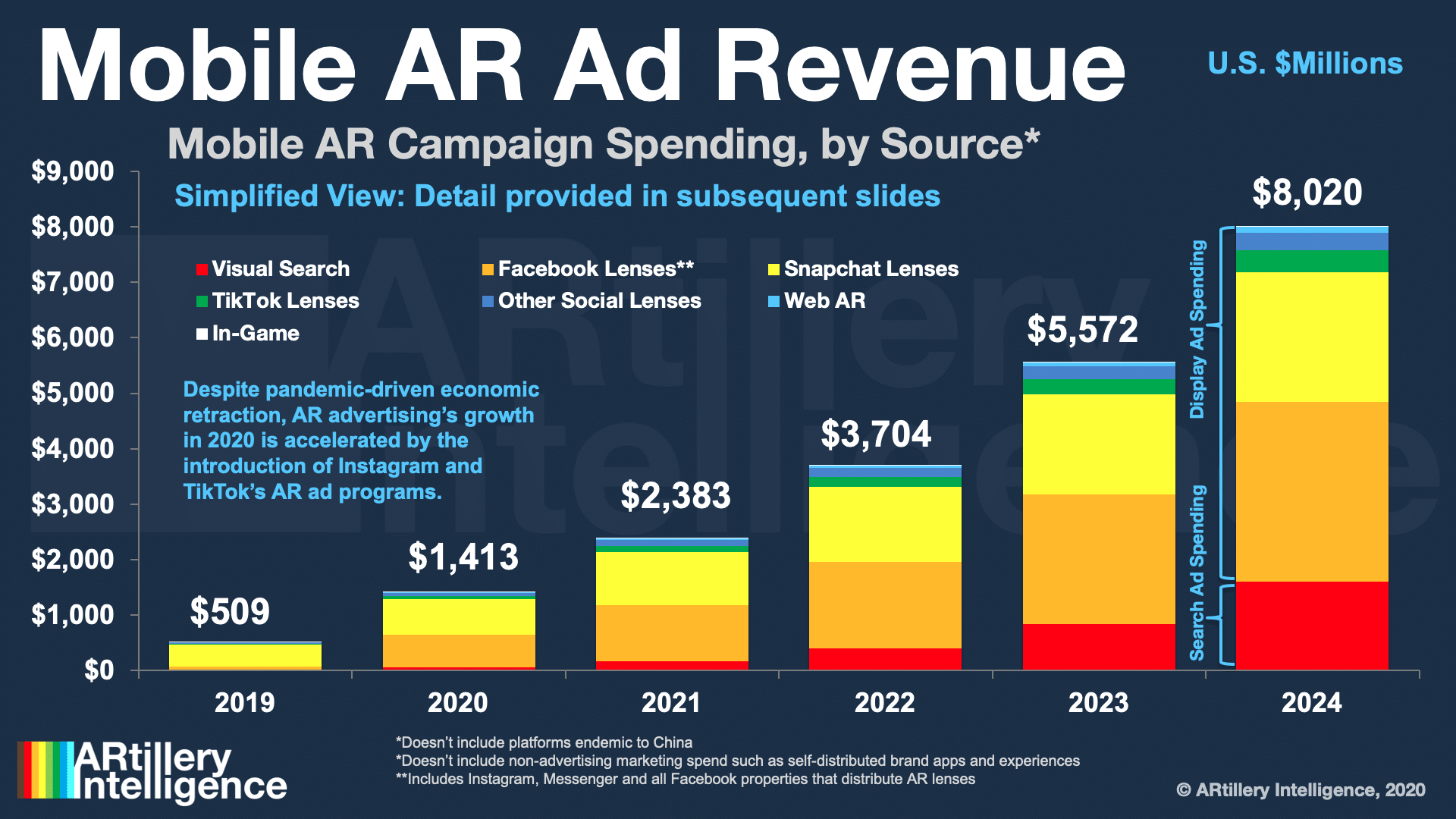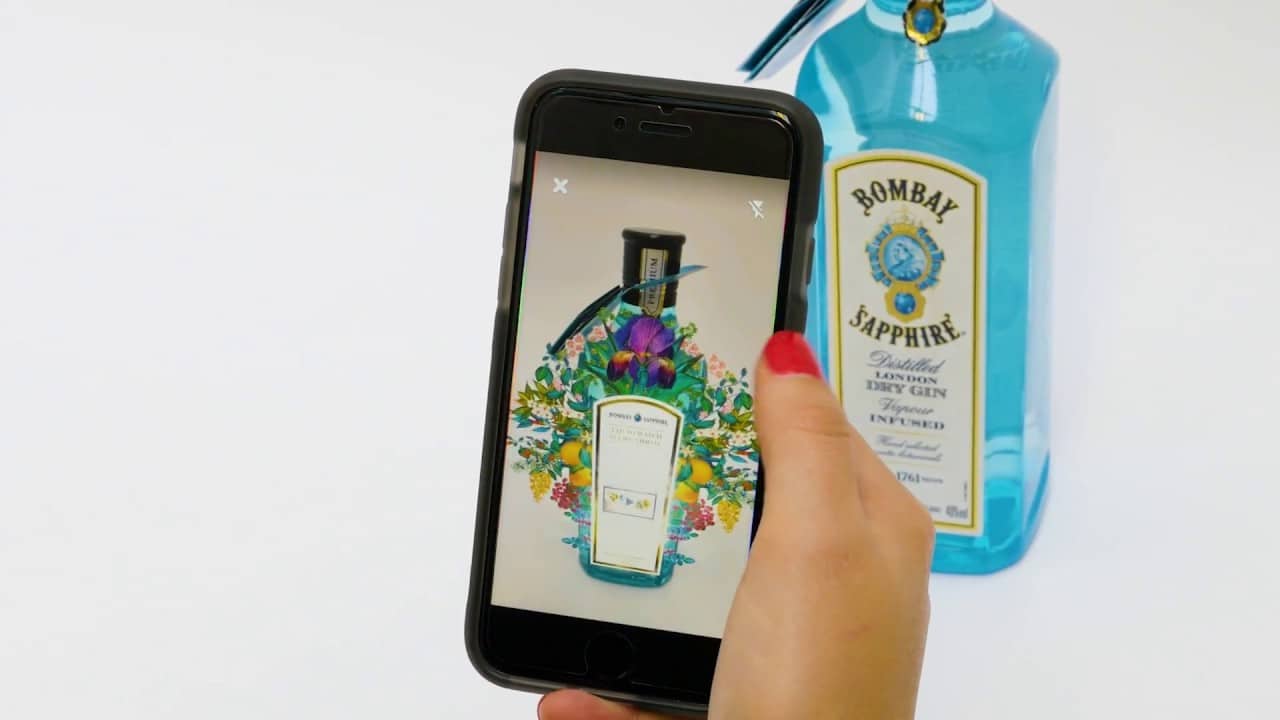
![]() ARtillery Briefs is a video series that offers insights in under 5 minutes. Each episode summarizes strategic takeaways from ARtillery’s original reports and market forecasts. See below narrative takeaways and embedded video. For the full library, subscribe to ARtillery PRO.
ARtillery Briefs is a video series that offers insights in under 5 minutes. Each episode summarizes strategic takeaways from ARtillery’s original reports and market forecasts. See below narrative takeaways and embedded video. For the full library, subscribe to ARtillery PRO.
Among AR sub-sectors that we examine, one of the most popular and revenue-producing is AR advertising. We’re talking branded AR lenses in channels like Facebook and Snapchat that let consumers visualize products on “spaces & faces” through the smartphone camera.
Revenue from these paid campaigns is expected to reach $1.4 billion this year according to the estimates of our research arm ARtillery Intelligence, growing to more than $8 billion by 2024. But key questions include how is that coming together? What’s driving it? And who’s doing what?
This is the topic of the latest report from ARtillery Intelligence, continuing in Part II of the series with twelve in-depth case studies that build on the principles in Part I. It’s also the topic of the latest ARtillery Briefs episode, which you can see below along with narrative takeaways.
Spanning the Funnel
As covered in Part I, AR advertising involves paid media placements that allow consumers to activate their smartphone camera to overlay branded animations on the real world. The spending totals above don’t include brands’ self-distributed AR such as their own apps.
Momentum in AR advertising is driven by a combination of user demand for immersive experiences — especially around socially fueled lenses — and advertisers’ attraction to the medium. The latter results from their interest in demonstrating products in 3D.
Beyond motivation from “creative juices,” the business case is equally strong, given campaign performance metrics explored below. AR advertising’s versatility also stems from its ability to span the purchase funnel from upper-funnel brand awareness to lower-funnel conversions.
This is rare among ad media as popular formats are usually tied to funnel stages. Broadcast media and display ads for example shine in upper-funnel audience reach, while search embodies lower-funnel consumer intent. AR campaigns are happening throughout the funnel.

Naming Names
Starting at the top of the funnel, AR campaigns are proving that they can reach massive audiences, and with depth of engagement. For example, Purina achieved 172 million impressions and 30-second average playtimes for its social lens campaign.
In the mid-funnel, we see campaigns that draw users closer to a transaction through AR games, scoring reward points, or sharing lenses socially. One example is Miller Lite’s 25 percent lift in brand favorability and 3-minute session lengths for its St. Patrick’s Day AR campaign.
On to the lower funnel, brands are achieving high conversion rates through AR product visualization. For example, a few food-based lenses boosted what we call craveability — such as lenses from Panera and Papa Johns, which achieved as high as 25 percent conversion rates.
Those are just a few examples but they demonstrate is AR’s range of applicability across various product categories and verticals. This will accelerate as AR migrates more to the rear-facing camera to augment the broader canvas of the physical world, versus just selfie fodder.

Tactical Takeaways
So what were lessons from these and other campaigns examined in ARtillery’s report? One key takeaway is that greater success is seen from brands that commit to AR as opposed to doing one-off campaigns to “check a box”, appear innovative or win advertising awards.
That longer-term commitment can be beneficial on a few levels. It can help brands to gain a competitive edge in developing competency in AR and growing with it. Moreover, it allows brands to amortize the cost and time of upfront learning curves over several campaigns.
Another key lesson shown by these AR campaigns is that technical complexity isn’t always required for AR success. It’s better to prioritize user experience and an overall fun factor. For example, use graphics with low poly counts that are more reliable than they are robust.
In the same spirit of keeping it simple, Web AR has advantages in lower-friction activation through web links or QR codes. Speaking of which, marker-based AR, though rudimentary, has advantages in engaging users through a physical prompt — a nudge they need at this stage.

Mobile Advertising in 2010
That just scratches the surface but you can see more in the full report and ARtillery Briefs episode below. In closing, we’ll note that there’s ample opportunity in AR advertising for brand marketers (the buy-side), as well as AR startups and ad-tech players (the sell-side).
For example, a value chain is developing around scalable 3D asset creation for large product libraries. Analytics to better capture AR engagement are also developing. So think of it like mobile advertising in 2010 — lots of headroom and opportunity, but also lots more to learn.
